Nanorattles ryster nye muligheder for sygdomsdetektion
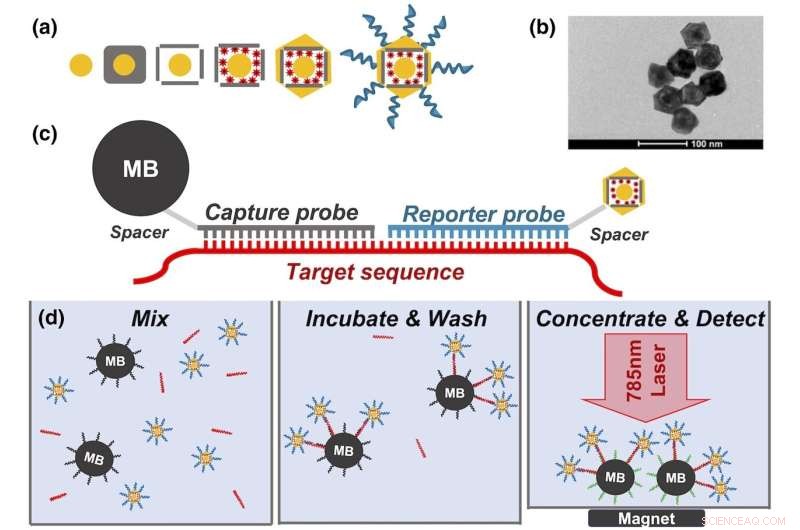
(a) Trin i nanorattlesyntese:20 nm Au-sfærer, vækst af Ag-terning, galvanisk udskiftning, der resulterer i Au@Ag-bur, farvestofbelastning, endelig Au-coating og DNA-probefunktionalisering. (b) TEM for nanoratle. (c) Hybridiseringsskema for nanorattle og magnetisk perlehybridiseringsassay. (d) Nanorattle-analysetrin:bland magnetiske perler, nanorangler og mål; inkubere; koncentrere; og opdage. TEM, transmissionselektronmikroskopi. Kredit:Journal of Raman Spectroscopy (2022). DOI:10.1002/jrs.6447
Forskere ved Duke University har udviklet en unik type nanopartikel kaldet en "nanorattle", der i høj grad forbedrer lyset, der udsendes inde fra dens ydre skal.
Fyldt med lysspredningsfarvestoffer kaldet Raman-reportere, der almindeligvis bruges til at påvise biomarkører for sygdom i organiske prøver, kan metoden forstærke og detektere signaler fra separate typer nanoprober uden at skulle bruge en dyr maskine eller læge til at læse resultaterne.
I en lille proof-of-concept-undersøgelse identificerede nanorattlerne nøjagtigt hoved- og halskræft gennem en AI-aktiveret point-of-care-enhed, der kunne revolutionere, hvordan disse kræftformer og andre sygdomme opdages i områder med lav ressource for at forbedre global sundhed.
Resultaterne blev vist online den 2. september i Journal of Raman Spectroscopy .
"Konceptet med at fange Raman-reportere i disse såkaldte nanorattles er blevet gjort før, men de fleste platforme havde svært ved at kontrollere de indvendige dimensioner," sagde Tuan Vo-Dinh, R. Eugene og Susie E. Goodson Distinguished Professor of Biomedical Engineering ved Duke.
"Vores gruppe har udviklet en ny type sonde med et præcist afstembart mellemrum mellem den indre kerne og den ydre skal, som giver os mulighed for at indlæse flere typer Raman-reportere og forstærke deres udsendelse af lys kaldet overfladeforstærket Raman-spredning," Vo-Dinh sagde.
For at lave nanorattler starter forskerne med en solid guldkugle på omkring 20 nanometer bred. Efter at have dyrket et lag sølv omkring guldkernen for at lave en større kugle (eller terning), bruger de en korrosionsproces kaldet galvanisk erstatning, der udhuler sølvet og skaber en burlignende skal omkring kernen. Strukturen gennemblødes derefter i en opløsning indeholdende positivt ladede Raman-reportere, som trækkes ind i det ydre bur af den negativt ladede guldkerne. De ydre skrog dækkes derefter af et ekstremt tyndt lag guld for at låse Raman-reporterne inde.
Resultatet er en nanosfære (eller nanokube) omkring 60 nanometer bred med en arkitektur, der ligner en rangle - en guldkerne fanget i en større ydre sølv-guldskal. Afstanden mellem de to er kun omkring et par nanometer, hvilket er lige stort nok til at passe til Raman-reporterne.
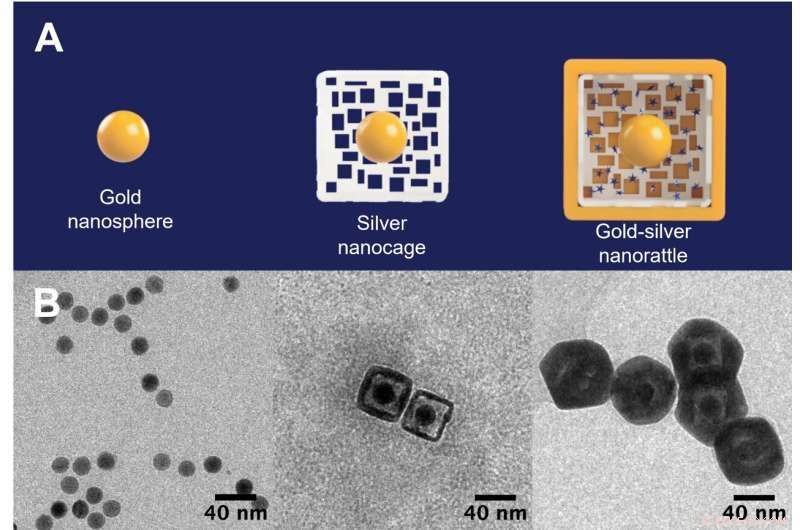
De begyndende guldnanosfærefrø (til venstre) er omgivet af et hult, porøst sølvbur (midten) og bliver til en nanorattle fyldt med lysspredende farvestoffer inde i en ydre guldskal (højre). Nanorattlerne kan forstærke og registrere signaler fra separate typer nanoprober uden at skulle bruge en dyr maskine eller læge til at læse resultaterne. Kredit:Tuan Vo-Dinh, Duke University
Disse snævre tolerancer er afgørende for at kontrollere den Raman-signalforbedring, som nanorattlerne producerer.
When a laser shines on the nanorattles, it travels through the extremely thin outer shell and hits the Raman reporters within, causing them to emit light of their own. Because of how close the surfaces of the gold core and the outer gold/silver shell are together, the laser also excites groups of electrons on the metallic structures, called plasmons. These groups of electrons create an extremely powerful electromagnetic field due to the plasmons' interaction of the metallic core-shell architecture, a process called plasmonic coupling, which amplifies the light emitted by the Raman reporters millions of times over.
"Once we had the nanorattles working, we wanted to make biosensing devices to detect infectious diseases or cancers before people even know they're sick," Vo-Dinh said. "With how powerful the signal enhancement of the nanorattles is, we thought we could make a simple test that could be easily read by anybody at the point-of-care."
In the new paper, Vo-Dinh and his collaborators apply the nanorattle technology to a lab-on-a-stick device capable of detecting head and neck cancers, which appear anywhere between the shoulders and the brain, typically in the mouth, nose and throat. Survival rate for these cancers have hovered between 40 and 60 percent for decades. While those statistics have improved in recent years in the United States, they have gotten worse in low-resource settings, where risk factors such as smoking, drinking and betel nut chewing are much more prevalent.
"In low-resource settings, these cancers often present in advanced stages and result in poor outcomes due in part to limited examination equipment, lack of trained healthcare workers and essentially non-existent screening programs," said Walter Lee, professor of head and neck surgery and communication sciences and radiation oncology at Duke, and a collaborator on the research.
"Having the ability to detect these cancers early should lead to earlier treatment and improvement in outcomes, both in survival and quality of life," Lee said. "This approach is exciting since it does not depend on a pathologist review and potentially could be used at the point of care."
The prototype device uses specific genetic sequences that act like Velcro for the biomarkers the researchers are looking for—in this case, a specific mRNA that is overly abundant in people with head and neck cancers. When the mRNA in question is present, it acts like a tether that binds nanorattles to magnetic beads. These beads are then concentrated and held in place by another magnet while everything else gets rinsed away. Researchers can then use a simple, inexpensive handheld device to look for light emitted from the nanorattles to see if any biomarkers were caught.
In the experiments, the test determined whether or not 20 samples came from patients that had head and neck cancer with 100% accuracy. The experiments also showed that the nanorattle platform is capable of handling multiple types of nanoprobes, thanks to a machine learning algorithm that can tease apart the separate signals, meaning they can target multiple biomarkers at once. This is the goal of the group's current project funded by the National Institutes of Health.
"Many mRNA biomarkers are overly abundant in multiple types of cancers, while other biomarkers can be used to evaluate patient risk and future treatment outcome," Vo-Dinh said. "Detecting multiple biomarkers at once would help us differentiate between cancers, and also look for other prognostic markers such as Human Papillomavirus (HPV), and both positive and negative controls. Combining mRNA detection with novel nanorattle biosensing will result in a paradigm shift in achieving a diagnostic tool that could revolutionize how these cancers and other diseases are detected in low-resource areas." + Udforsk yderligere
Silver-plated gold nanostars detect early cancer biomarkers
 Varme artikler
Varme artikler
-
 Forskere syntetiserer nye nanotråde for at forbedre højhastighedskommunikationVækstmekanismen og hurtig 1550 nm IR-detektion af de enkeltkrystallinske In0.28Ga0.72Sb ternære nanotråde Kredit:HAN Ning Kinesiske videnskabsmænd har syntetiseret nye nanotråde med høj mobilitet
Forskere syntetiserer nye nanotråde for at forbedre højhastighedskommunikationVækstmekanismen og hurtig 1550 nm IR-detektion af de enkeltkrystallinske In0.28Ga0.72Sb ternære nanotråde Kredit:HAN Ning Kinesiske videnskabsmænd har syntetiseret nye nanotråde med høj mobilitet -
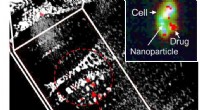 Forskere kvantificerer lægemiddellevering fra nanopartikler inde i en celleHyperspektral billeddannelse detekterer og kvantificerer levering af lægemiddel fra en nanopartikel i et 3D-rum. Stiplet pil og cirkel indikerer, at kun 3 procent af lægemidlet er blevet frigivet fra
Forskere kvantificerer lægemiddellevering fra nanopartikler inde i en celleHyperspektral billeddannelse detekterer og kvantificerer levering af lægemiddel fra en nanopartikel i et 3D-rum. Stiplet pil og cirkel indikerer, at kun 3 procent af lægemidlet er blevet frigivet fra -
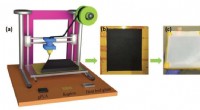 Forskere åbner ny jord inden for trådløs energigenerering til fremtidige elektroniske gadgetsW-TENG er 3-D printet ud af en grafen-PLA nanofiber (A), skabe den nederste elektrode af teknologien (B). En teflonplade tilføjes derefter som den øverste elektrode (C). Kredit: Adv. Energi Mater . 2
Forskere åbner ny jord inden for trådløs energigenerering til fremtidige elektroniske gadgetsW-TENG er 3-D printet ud af en grafen-PLA nanofiber (A), skabe den nederste elektrode af teknologien (B). En teflonplade tilføjes derefter som den øverste elektrode (C). Kredit: Adv. Energi Mater . 2 -
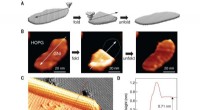 Ved hjælp af et scanning tunneling mikroskop til at lave origami strukturer ud af grafenKonstruktion af atomisk veldefinerede foldede GNSer af STM origami. (A) Skematisk grafik af foldning og udfoldning af et BNI langs en vilkårlig retning (sorte pile). (B) Eksperimentel realisering af (
Ved hjælp af et scanning tunneling mikroskop til at lave origami strukturer ud af grafenKonstruktion af atomisk veldefinerede foldede GNSer af STM origami. (A) Skematisk grafik af foldning og udfoldning af et BNI langs en vilkårlig retning (sorte pile). (B) Eksperimentel realisering af (
- Forskere laver skalerbare arrays af byggeklodser til ultratynd elektronik
- Tre måder for videnskabsmænd at kommunikere deres resultater af videnskabelig forskning
- Sætter guld- og platinstandarder, hvor få har gået før
- Nordkorea udforsker sanktionssikre energiteknologier
- Grønnere biomaterialer og stilladser, der bruges i regenerativ medicin
- Ny kæmpe exoplanet opdaget med TESS


